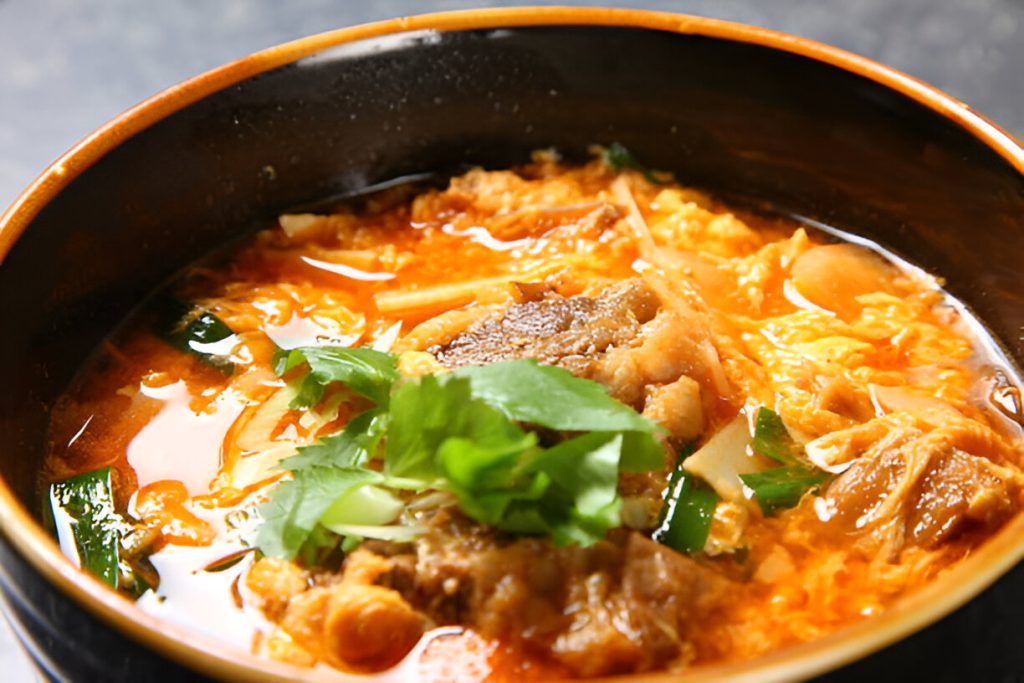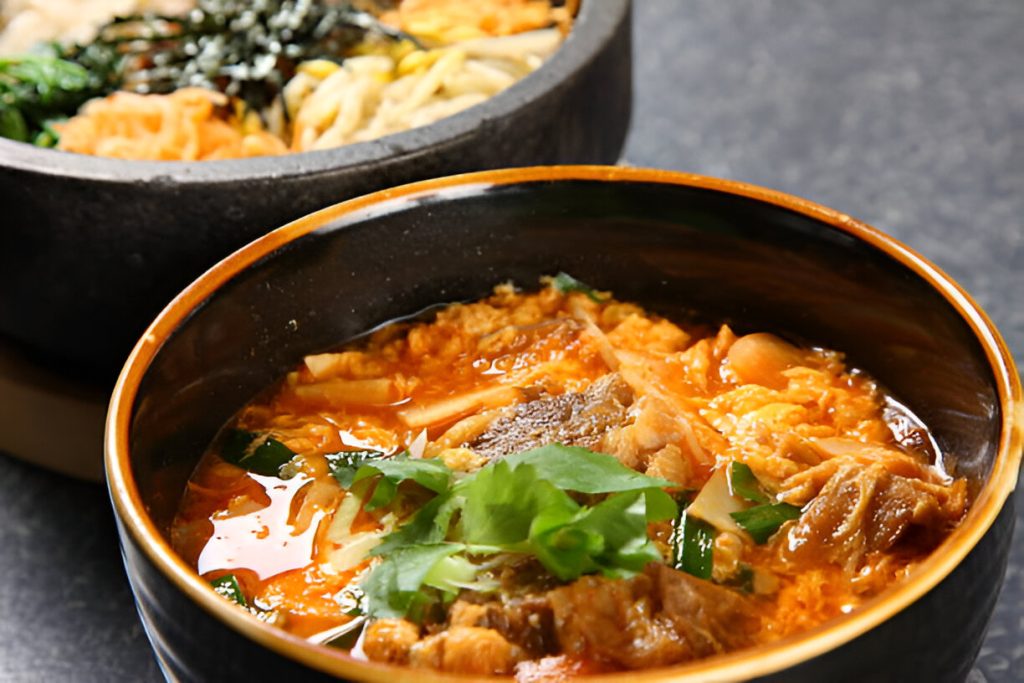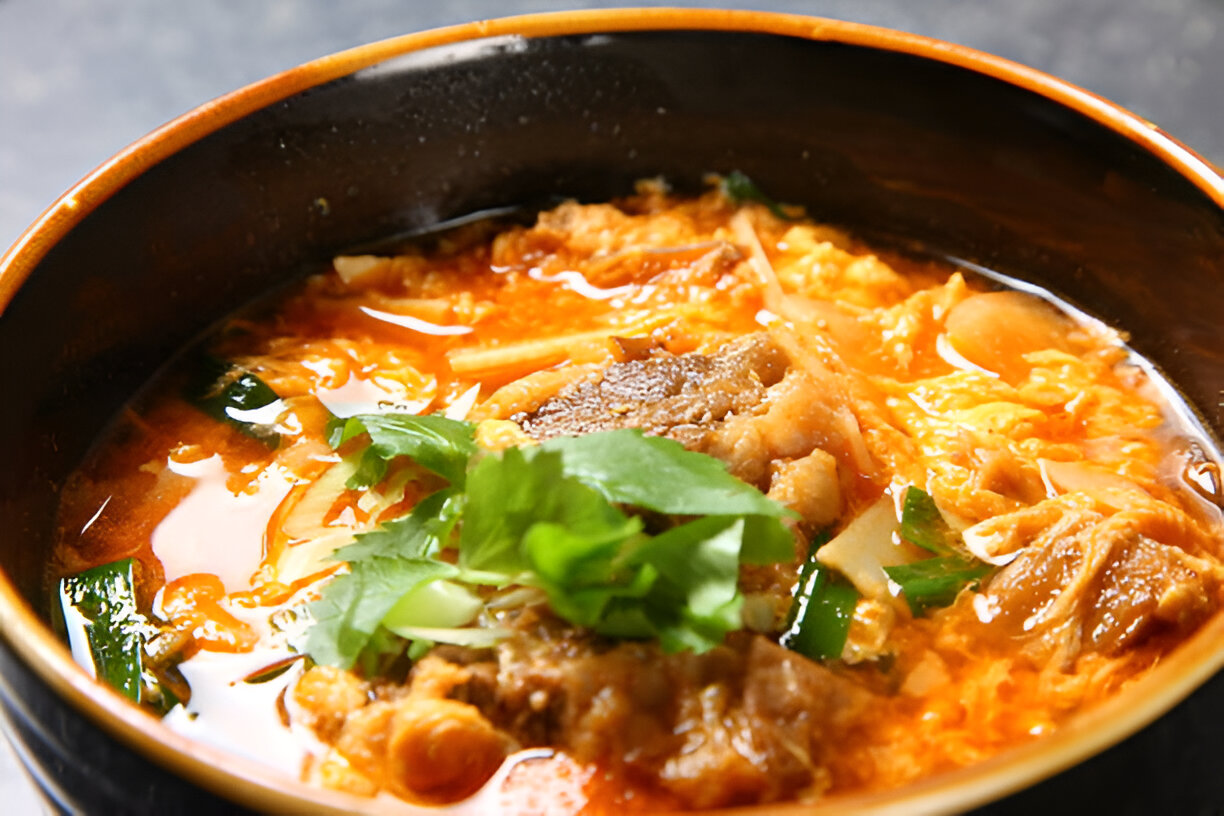Kimchi Stew with Beef Recipe
Kimchi Stew with Beef, or Kimchi Jjigae, is a cornerstone of Korean cuisine that brings together the bold, fermented tang of kimchi with the rich, tender flavors of beef. This hearty dish is beloved for its complexity, where layers of spice, umami, and freshness come alive in every spoonful. Perfect for chilly evenings or any time you’re craving comfort food, this stew offers warmth and satisfaction, making it a go-to for families and gatherings alike. Its versatility allows it to shine as a simple meal or a centerpiece on a spread of Korean dishes.

Ingredients Breakdown
Each ingredient in Kimchi Stew with Beef plays a vital role in creating its iconic flavor profile, offering a balance of spice, depth, and heartiness.
Kimchi, aged to perfection, serves as the soul of the dish. Its tangy, spicy, and slightly sweet notes form the backbone of the stew. Older kimchi, with its stronger fermented flavors, enhances the depth of the broth, making the stew irresistible.
The beef, whether short rib, brisket, or sliced chuck, brings a tender, savory richness. These cuts are ideal for slow cooking, as they release their juices into the broth, adding a deep umami taste. The melt-in-your-mouth texture of the beef complements the crunch of the kimchi.
Tofu and vegetables provide a gentle contrast to the bold flavors. Tofu absorbs the broth beautifully, offering soft, silky bites, while vegetables like onions and green onions add sweetness and freshness.
The seasonings, including gochujang, gochugaru, soy sauce, and sesame oil, tie everything together. These quintessential Korean spices and condiments provide the signature heat, smokiness, and aroma that make the dish unmistakably Korean.
Step-by-Step Cooking Guide
Crafting Kimchi Stew with Beef is a journey of layering flavors, where each step contributes to the dish’s complexity.
Preparation is key to ensuring a seamless cooking experience. Begin by chopping the kimchi, slicing the beef into bite-sized pieces, and cubing the tofu. Keep all ingredients measured and ready to add to the pot as needed.
Searing the beef in sesame oil is a foundational step. This quick process caramelizes the meat, enhancing its flavor and creating a base for the stew. The sesame oil imparts a nutty aroma that pairs beautifully with the beef.
Layering the flavors begins with sautéing the kimchi and seasonings. Cooking the kimchi with gochujang, gochugaru, soy sauce, and garlic brings out its natural sweetness while mellowing its acidity. This creates a robust base for the stew.
Simmering is where the magic happens. Adding beef stock or water and letting the mixture simmer gently allows the flavors to meld. The slow cooking process tenderizes the beef while infusing the broth with deep, savory notes.
Adding tofu and finishing touches completes the dish. The tofu absorbs the flavorful broth, while the green onions provide a burst of freshness. A final taste test ensures the seasoning is perfectly balanced before serving.

Recipe Tips
Customizing Heat Levels:
Adjust the gochujang and gochugaru amounts to suit your spice tolerance. For a milder stew, reduce the chili flakes and balance the flavor with a touch of sugar.
Stock Options:
If beef stock isn’t available, a rich vegetable stock or even water with a dash of soy sauce can work as a substitute.
Aged Kimchi Benefits:
Use kimchi that has been fermenting for at least a few weeks for a more pronounced tang and depth of flavor.
Make-Ahead Suggestions:
This stew tastes even better the next day. Store leftovers in an airtight container and reheat gently on the stove to retain its rich taste.
What to Serve With This Recipe
Kimchi Stew with Beef is best paired with simple yet complementary sides to complete the meal.
Steamed rice is a classic accompaniment, helping to balance the heat and soak up the flavorful broth. It’s an essential part of the Korean dining experience.
Korean side dishes, or banchan, add variety and texture. Try pairing the stew with seasoned spinach, spicy cucumber salad, or pickled radish for a traditional spread.
For drinks, barley tea or a light beer makes an excellent choice. The tea’s nutty undertones and the beer’s crispness provide a refreshing contrast to the rich stew.
Variations and Substitutions
This versatile recipe allows for many adaptations to suit dietary preferences or ingredient availability.
Protein options can include chicken, pork, or even seafood such as shrimp or clams. Each protein brings its unique flavor profile to the stew.
For a vegan version, replace the beef with hearty mushrooms like shiitake or king oyster, and use vegetable stock in place of beef stock. The result is just as satisfying and flavorful.
Ingredient swaps are also possible. If gochujang isn’t available, a mix of chili paste and a pinch of sugar can mimic its flavor. Firm tofu or tempeh can be used in place of silken tofu for a different texture.
Frequently Asked Questions
Can I use fresh kimchi instead of aged kimchi?
Fresh kimchi can be used, but the stew may lack the depth of flavor that aged kimchi provides. Consider adding a splash of vinegar for extra tang.
How do I make this recipe less spicy?
Reduce the amount of gochugaru and gochujang, and add a touch of sugar to balance the heat.
What is the best way to store leftovers?
Store the cooled stew in an airtight container in the refrigerator for up to three days. Reheat on the stove for the best flavor.
Can I freeze Kimchi Stew?
Yes, the stew freezes well. Portion it into freezer-safe containers and freeze for up to two months. Thaw overnight in the fridge before reheating.
What other vegetables can I add to this stew?
Mushrooms, zucchini, and napa cabbage are excellent additions that complement the flavors of the stew.
Kimchi Stew with Beef is a celebration of bold flavors and comforting textures, making it an iconic dish in Korean cuisine. Its versatility ensures that it can be adapted to different tastes and occasions, whether it’s a weeknight dinner or a special meal for guests.
Serve it hot with a bowl of steamed rice, and don’t forget to include a few banchan for an authentic Korean dining experience. The stew’s robust flavors will leave a lasting impression, encouraging you to make it again and explore new variations.

Ingredients
2 cups aged kimchi, chopped
200g (7 oz) beef (short rib, brisket, or sliced beef chuck)
3 cups water or beef stock
1 tbsp Korean red chili paste (gochujang)
1 tsp Korean red chili flakes (gochugaru)
1 tbsp sesame oil
1 block tofu, sliced into cubes
1/2 onion, sliced
2 green onions, chopped
1 tsp minced garlic
1 tbsp soy sauce
1/2 tsp sugar (optional)
Fresh cilantro or parsley for garnish (optional)
Instructions
Warm sesame oil in a medium-sized pot over medium heat. Once heated, add the beef slices and sauté until they are golden brown and slightly caramelized, approximately 2-3 minutes. Stir occasionally to ensure even cooking.
Incorporate the chopped kimchi into the pot, followed by the gochujang, gochugaru, soy sauce, and minced garlic. Stir well to coat the beef and kimchi evenly with the seasonings. Cook for 5-7 minutes, allowing the kimchi to soften and its flavors to deepen.
Pour in the water or beef stock, stirring gently to combine. Raise the heat to bring the mixture to a boil, then lower it to a simmer. Allow the stew to cook for 20 minutes, letting the beef tenderize and the flavors fully infuse the broth.
Carefully add the tofu cubes and sliced onion to the pot. Let the stew simmer for an additional 5 minutes, ensuring the tofu absorbs the rich broth and the onion softens without losing its texture.
Taste the stew and adjust the seasoning as needed with soy sauce or a pinch of sugar for balance. Just before removing the pot from heat, sprinkle the chopped green onions on top.
Ladle the piping-hot kimchi stew into individual bowls and garnish with fresh cilantro or parsley for a vibrant touch. Pair with a serving of steamed rice for a hearty and satisfying meal.

Kimchi Stew with Beef Recipe
Ingredients
- 2 cups aged kimchi chopped
- 200 g 7 oz beef (short rib, brisket, or sliced beef chuck)
- 3 cups water or beef stock
- 1 tbsp Korean red chili paste gochujang
- 1 tsp Korean red chili flakes gochugaru
- 1 tbsp sesame oil
- 1 block tofu sliced into cubes
- 1/2 onion sliced
- 2 green onions chopped
- 1 tsp minced garlic
- 1 tbsp soy sauce
- 1/2 tsp sugar optional
- Fresh cilantro or parsley for garnish optional
Instructions
- Warm sesame oil in a medium-sized pot over medium heat. Once heated, add the beef slices and sauté until they are golden brown and slightly caramelized, approximately 2-3 minutes. Stir occasionally to ensure even cooking.
- Incorporate the chopped kimchi into the pot, followed by the gochujang, gochugaru, soy sauce, and minced garlic. Stir well to coat the beef and kimchi evenly with the seasonings. Cook for 5-7 minutes, allowing the kimchi to soften and its flavors to deepen.
- Pour in the water or beef stock, stirring gently to combine. Raise the heat to bring the mixture to a boil, then lower it to a simmer. Allow the stew to cook for 20 minutes, letting the beef tenderize and the flavors fully infuse the broth.
- Carefully add the tofu cubes and sliced onion to the pot. Let the stew simmer for an additional 5 minutes, ensuring the tofu absorbs the rich broth and the onion softens without losing its texture.
- Taste the stew and adjust the seasoning as needed with soy sauce or a pinch of sugar for balance. Just before removing the pot from heat, sprinkle the chopped green onions on top.
- Ladle the piping-hot kimchi stew into individual bowls and garnish with fresh cilantro or parsley for a vibrant touch. Pair with a serving of steamed rice for a hearty and satisfying meal.

